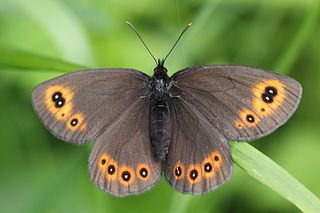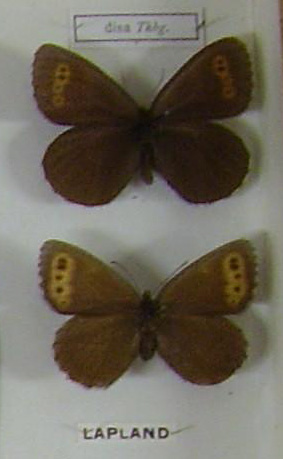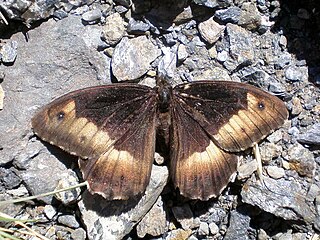
The Queen of Spain fritillary is a butterfly of the family Nymphalidae.

The Scotch argus is a butterfly of the family Nymphalidae. In spite of its English name argus, it is not a close relation of the brown argus nor the northern brown argus.

Melitaea diamina, the false heath fritillary, is a butterfly of the family Nymphalidae.

The purple-edged copper is a butterfly of the family Lycaenidae.

Erebia alberganus, the almond ringlet or almond-eyed ringlet, is a butterfly of the family Nymphalidae.

Erebia medusa, the woodland ringlet, is a member of the subfamily Satyrinae of the family Nymphalidae.

Erebia tyndarus, the Swiss brassy ringlet, is a European brush-footed butterfly species of the subfamily Satyrinae.

Colias palaeno, known by the common names moorland clouded yellow, palaeno sulphur, and pale Arctic clouded yellow, is a butterfly in the family Pieridae.

The Arctic ringlet or Disa alpine is a member of the subfamily Satyrinae of family Nymphalidae. It is associated with wet muskeg and bogs in subarctic and Arctic climates, and is often found near the tree-line. The larva overwinters twice before undergoing metamorphosis into an adult. It is found in Arctic Europe, Arctic European Russia, Sajan, Irkutsk, Yakutsk, Yablonoi and Arctic North America.

The bright eyed ringlet is a member of the Satyridae subfamily of Nymphalidae. It is a high mountain butterfly found in the Pyrenees, Massif Central, Alps and Balkan mountains. It has recently been confirmed to occur in the southern chain of the Carpathians.

The marbled ringlet is a member of the subfamily Satyrinae of the family Nymphalidae.

The sooty ringlet is a member of the subfamily Satyrinae of family Nymphalidae. It is a high-altitude butterfly found in the Alps and Apennine Mountains on heights between 1,900 and 3,000 meters in Austria, Germany, France, Switzerland, Italy and Slovenia.

Hipparchia fagi, the woodland grayling, is a butterfly of the family Nymphalidae.

Boloria titania, the Titania's fritillary or purple bog fritillary, is a butterfly of the subfamily Heliconiinae of the family Nymphalidae.

Limenitis reducta, the southern white admiral, is a butterfly of the family Nymphalidae.

Melitaea didyma, the spotted fritillary or red-band fritillary, is a Palearctic butterfly of the family Nymphalidae.

Pontia edusa, the eastern Bath white, is a butterfly in the family Pieridae.

Minois dryas, the dryad, is a butterfly of the family Nymphalidae.

Erebia cassioides, the common brassy ringlet, is a member of the subfamily Satyrinae of family Nymphalidae.

Erebia melampus, the lesser mountain ringlet, is a member of the subfamily Satyrinae of the family Nymphalidae.

























